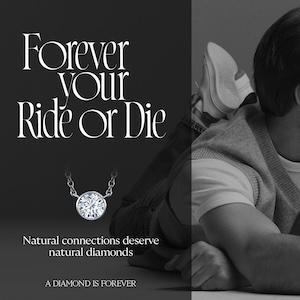
Trade groups for the lab-grown diamond business have a bad track record. The International Grown Diamond Association version 2.0 has seemingly packed it in, and the Lab-Grown Diamond Council never got off the ground.
But the newest entry, the Grown Diamond Trade Organization (GDTO), is trying a different tack. For one, it’s a for-profit LLC (limited liability corporation), whose main business will be issuing lab-grown diamond reports, beginning in the fall. Marty Hurwitz, the MVI Marketing CEO who’s been involved with past groups, is GDTO’s executive director.
At JCK Las Vegas, I spoke with David Sherwood, CEO of Daniel’s Jewelers, a Culver City, Calif.–based chain with over 100 stores, who serves on the GDTO’s advisory board and holds its corporate registration. I should note that some in the industry have expressed reservations about the “sustainability score” on the GDTO reports, which Sherwood admits is not “perfect.” (I wouldn’t be surprised if the group has to change that aspect.) But he does raise provocative points about grading reports and lab-grown diamonds, as you’ll see below.
Can you tell me about this new group?
The Grown Diamond Trade Organization grew out of a number of people’s angst and frustration over the fact that there was no unified voice for the lab-grown industry, and the only marketing message was “It’s the same, but cheaper.” That is not sustainable in the long term. As more of us see lab-grown diamonds grow as a total percentage of our merchandise, we saw the writing on the wall.
There’s been other organizations out there but they’ve all been run by producers and growers. I wanted retailers to be part of it, and to get other retailers involved.
Why did you set this up as a for-profit venture?
I’ve been in business for years, and I know a profit motive allows you to actually accomplish things. What I’ve seen in other organizations trying to unite the industry is that without a revenue source, and without a means of supporting yourself as an organization, the organization just becomes a lot of talking heads and never really gets anything accomplished.
Why do you feel the need to create reports for lab-growns?
One of the biggest issues we all have is the huge cost of [grading reports] for diamonds that really shouldn’t be certified in the way mined diamonds are certified. If you’re pulling something out of the earth, you need to send it to a third party. You manufacture something to certain specifications, you shouldn’t send it to a third-party laboratory.
There’s also a logistics issue. If you’re doing the whole piece, you have to send it twice. You have to send the center stone, then mount the center stone, then send it back, and you have to get the cert matched. It doesn’t make sense.
What is the lab actually doing? They’re telling me that something is a VS1, when it was designed to be a VS1, quality-controlled to be a VS1, and the retailer agreed [through its quality controls] it’s a VS1. I don’t need [a lab to tell me] that.
When Samsung produces a television and they tell you it’s 65 inches and 1,080 pixels, you don’t take it out of the box and send it to an independent lab. This is a manufactured product. This is not a mined product that came out of the earth, that we don’t know what it is. The fundamentals of how certification happens needs to change.
Why don’t you just issue Daniel’s Jewelers reports?
A couple of reasons. The first is that an independent party is something the consumer has been trained to want. We have done Daniel’s reports in the past. The thing that this third party is able to do that Daniel’s Jewelers was not able to do is [provide information on] sustainability.
For the last year I’ve been pushing all of my lab-grown vendors to provide sustainability data. I have said, “I want to know: What kind of manufacturing process do you use, HPHT or CVD?” The answer: “I don’t know.” We asked, “Where do you produce? Where did you get the rough from?” “I don’t know.” I said there has to be more transparency. So this organization will require people to provide that information as a requirement to join.
How do the sustainability reports work? Will they include data on electricity use and methane emissions?
The questions that the vendors will be asked to respond to include: percentage of renewable energy, labor rates, how they deal with waste products, etc. But in practice, there are some assumptions that are being made in the short term, as some of that information is just not available. [So we’ll use] proxies. Even if all I know is that you’re buying rough produced with HPHT in China, or CVD in India, just from that information we can make a relative call of which of the rough is more sustainable.
The sustainability rating is not perfect, but it’s a first step. A step toward transparency is better than none.
You did a lot of research on [the environmental impact of lab-grown diamonds]. It’s hard getting this information. The ranges that you came up with, when you did the research [in 2019], they haven’t gotten any tighter.
So will that data be publicly available?
We’re simplifying for the consumer. It will just be a score, a simple sustainability rating on a piece of jewelry, on a 0 to 100 scale. I don’t think it’s perfect.
How much will the reports cost?
They’re starting around $3. I think the majority will go for about $5.
Do you see this as competition for the grading labs?
My personal opinion is that [the labs] did a disservice to the entire industry by putting the certs of lab-grown next to the certs of mined. My customer walks in and it’s hard for me to tell a story about how these two products are different, when they see the same certs for both. I don’t think the labs should be in this business, frankly.
Don’t consumers want grading reports from a recognized lab?
[Daniel’s does] regular focus groups with customers. In one, we asked, “Which diamond certifying laboratory do you trust?” And we gave a bunch of names. We got about a 23% positive rating for GIA—which meant that the vast majority had not even heard of GIA. We also gave them GCAL, IGI. But the No. 2 lab, behind GIA, was a made-up lab called GAS. People have heard of gas, especially in California, so I guess they figured that’s something they’ve heard of. It said to me the name in the upper left corner of the cert is meaningless.
As far as promoting lab-grown, what will you do if this takes off?
Training, co-op advertising, such as billboards and other sort of materials. It’s similar to what the Diamond Promotion Service (DPS) used to do. I would love to have the organization be the DPS for lab-grown, and frankly, if the DPS came back for mined diamonds, I’d be the first one in. We need that. We need people to buy both lab-grown and mined diamonds for the right reasons.
(Photo courtesy of the Grown Diamond Trade Organization)
Follow JCK on Instagram: @jckmagazineFollow JCK on Twitter: @jckmagazine
Follow JCK on Facebook: @jckmagazine





